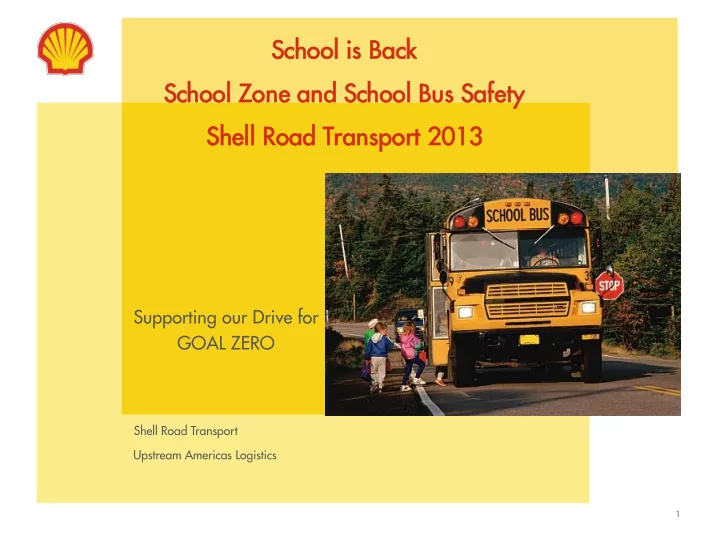

School is is Back School Zone and School Bus Safety Shell Road Transport 20 2013 13 Supporting our Drive for GOAL ZERO Shell Road Transport Upstream Americas Logistics 1
School Zone Safety ALWAYS obey the posted speed limits and observe times that school zones are in effect as they vary by jurisdiction. Typical limits are 30 Km/hour in Canada and 15 - 25 MPH in the US. Research* shows that most children (5-11 yrs) cannot judge how fast vehicles are moving. Their perception is all vehicles move at a maximum speed of 20 mph (~30 kph). Of all the possible ways to prevent an incident there is no substitute for slowing down when in the vicinity of a School or School Bus Zone. 2
School Bus Safety Red flashing lights and extended stop arms indicate that the bus has stopped, and children are getting on or off. On undivided roadways, with no physical barrier or median, vehicles must stop on both sides of the roadway and must wait until the red lights stop flashing before proceeding. Yellow flashing lights indicate that the bus is preparing to load or unload children. Motorists should slow down and prepare to stop their vehicles. The diagrams shown below indicate the requirements for stopping across Canada and most states in the USA. 3
Back to School Safety Children are more vulnerable than adults to being hit by a car. They can be less cautious than adults. They are shorter and smaller, making them harder to see. Slowing down in a school zone keeps children safe by reducing the likelihood of a collision and also by reducing the force of impact if there is a collision. The faster your vehicle is going, the longer it takes for you to slow down and the less time a child has to get out of your way. Motorists that violate traffic safety laws can expect a stiff penalty for driving unsafely in school zones and placing children at risk. However, there is no punishment more severe than the lifelong guilt and remorse for injuring or possibly killing a child. 4
Speaker’s Notes Slide 1: This presentation is designed to create awareness of the hazards and precautions required to ensure the safety of children in school zones and in or around school buses. Incidents resulting in child pedestrian fatalities are highest during the spring and fall, with the greatest number of child pedestrian deaths due to motor vehicle incidents occurring during the months of May and October. Slide 2: Watch out for school crossing guards and obey their signals. Watch out for children near schools, bus stops, sidewalks, in the streets, in school parking lots, etc. Passing other vehicles, changing lanes, and making U-Turns while driving in a school zone are unsafe and illegal. Remain extra vigilant by avoiding distractions such as eating, drinking, adjusting radio, or anything else that takes your attention away from driving. Kids don’t always wait for the traffic to stop, will run to the bus without looking, can cause distractions for drivers, and may cross in front of bus or other parked vehicles. There is also an increase of adolescent/teenage pedestrian incidents caused by electronic distractions such as cell phones and music from headphones. *Source of the research indicated in the slide: 2010 study from researchers at the University of London, news release, Nov. 23, 2010 http://btaoregon.org/2010/12/perception-of-traffic-speed-why-young-children-are-at-risk/ Slide 3: At the start of the school year new bus drivers may have limited experience driving larger vehicles. Bus drivers can be distracted by activities taking place on the bus. Other drivers may attempt to pass a bus to avoid the next required stop. It is important for motorists to know when they are NOT required to stop since stopping when not required creates high potential for rear-end collisions. Several states have slightly different wording for situations where stops are not required. Generally, passing from the front is allowed if the roadway is separated by a distinct median. This is defined as a separation of lanes by concrete, grass or open space. Some states allow passing when lanes are separated by a ‘painted median (this does not mean ‘turning lane). West Virginia, Arkansas (when the divider is less than 20ft wide), Mississippi, New York State are examples of states where drivers do have to stop for a stopped bus, when they are in the opposing traffic lanes on a divided highway. Examples of states that allow passing with a painted median include Texas which does recognize ‘painted medians’ as allowing passing from the front while Louisiana omits the ‘pai nted medians’ as allowed for passing. Be aware that out -of-state drivers are not likely to be aware of the different requirements. The alert driver will recognize the potential for this confusion and maintain ‘Time and Space’. Jurisdiction specific requirements for stopping for school buses can be found at http://drivinglaws.aaa.com/laws/school-buses/ Slide 4: Read Slide 5
Recommend
More recommend